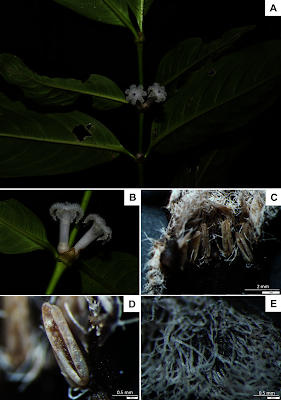 |
| Lasianthus ranongensis Sinbumr. & Napiroon, in Napiroon, Sinbumroong et Poopath, 2021. |
Abstract
We describe Lasianthus ranongensis Sinbumr. & Napiroon as a new species in the genus Lasianthus. The new taxon is intensively discussed through taxonomic affinities and information on its habitat, distribution and conservation status is provided. Moreover, line drawings and stereo microscope images of important fertile organs are demonstrated. The new species is morphologically similar to L. stipularis but differs in its having flattened branches (vs. terete), leaf blade elliptic-oblong shape of 15.0–20.0 × 4.0–6.0 cm (vs. oblanceolate-oblong 12.0–16.0 × 3.0–5.5 cm), 9–12 pairs of veins (vs. 9–10 pairs), stipule 5–7 mm long, half covering cymes (vs. 10–12.5 mm long, entirely covering cymes), four or five bracts narrowly lanceolate, 2.5–3.0 mm long (vs. bracts numerous, broadly triangular, 10–15 mm), flowers with cupular calyx (vs. with campanulate calyx), corolla villous on internal surface, and six or seven lobed (vs. pubescent on internal surface and four lobed) and drupes with five pyrenes (vs. with four pyrenes). It is also similar to L. pseudo-stipularis, but from which it is obviously distinguished by its stipule half covers cymes, secondary veins have 9–12 pairs of secondary veins, cupular calyx shape, six or seven lobed corolla, and drupe with five pyrenes, whereas L. pseudo-stipularis has stipule entirely covering cymes, 7–8 pairs of secondary veins, obconic calyx, four lobed corolla, and drupe with four pyrenes.
Lasianthus ranongensis Sinbumr.& Napiroon, sp. nov.
Diagnosis:–Lasianthus ranongensis is morphologically similar to Lasianthus stipularis Blume, but differs in its having flattened branches (vs. terete branches), elliptic-oblong lamina 15.0–20.0 × 4.0–6.0 cm (vs. oblanceolate-oblong 12.0–16.0 × 3.0–5.5 cm), 9–12 pairs of secondary veins (vs. 9–10 pairs), glabrous young branches (vs. puberulous), stipules half covering cymes (vs. entirely covering cymes), bracts 4–5, 2.5–3.0 mm long (vs. bracts numerous, 10–15 mm long), glabrous cupular calyx, (vs. hirsute and campanulate), and 6–7 lobed corolla which inside is villous (vs. four-lobed and pubescent inside). In addition, it is similar to L. pseudo-stipularis Amshoff ex Bakh.f. but differs by having cupular calyx (vs. obconic), six or seven-lobed corolla (vs. 4-lobed).
Distribution:– Endemic to Peninsular Thailand, known from Ngao Sub-district, Muang Ranong District, Ranong Province. It occurs only in tropical rainforest within Ngao National park at the West part peninsular Thailand.
Habitat:– Growing in shaded understory near or at the edges of streams in tropical rainforests, on metamorphic or granitic rock substrates at 70 m elevation.
Etymology:– The specific epithet refers to its occurrence in the Andaman tropical rainforest, Ranong Province, the West part of southern Thailand.
Common name:– Dara Pilas - ดาราพิลาส, this name refers to the flower which seems like a beautiful star.
Discussion:
Lasianthus ranongensis is a unique species but might be confused with L. stipularis, which is also found in peninsular Thailand, in having its similar habit and blue colored fruit. However, Lasianthus ranongensis is easily set aside from L. stipularis by the outstanding characteristics listed in the above diagnosis. In addition, this species is also similar to L. pseudo-stipularis. Both have large stipules but L. ranongensis presents a stipule with half covering cymes, leaves with 9–12 pairs of lateral veins, and cupular calyx. In contrast, Lasianthus pseudo-stipularis has a stipule that entirely covering cymes, leaves with secondary veins 7–8 pairs only, and obconic calyx. In addition, L. pseudo-stipularis distributed explicitly in Java and Sumatra in Indonesia.
Conclusions:
This study confirmed that Lasianthus ranongensis has morphological evidence as a new species that clearly distinguished from its resemble species. L. stipularis and L. pseudo-stipularis in both fertile and vegetative characters. These reports are useful for Flora of Thailand project to group of Lasianthus.
Tiwtawat Napiroon Aroon Sinbumroong and Manop Poopath. 2021. Lasianthus ranongensis (Rubiaceae), A New Species from Andaman Tropical Rainforest, Thailand. PeerJ. 9:e12320 . DOI: 10.7717/peerj.12320






